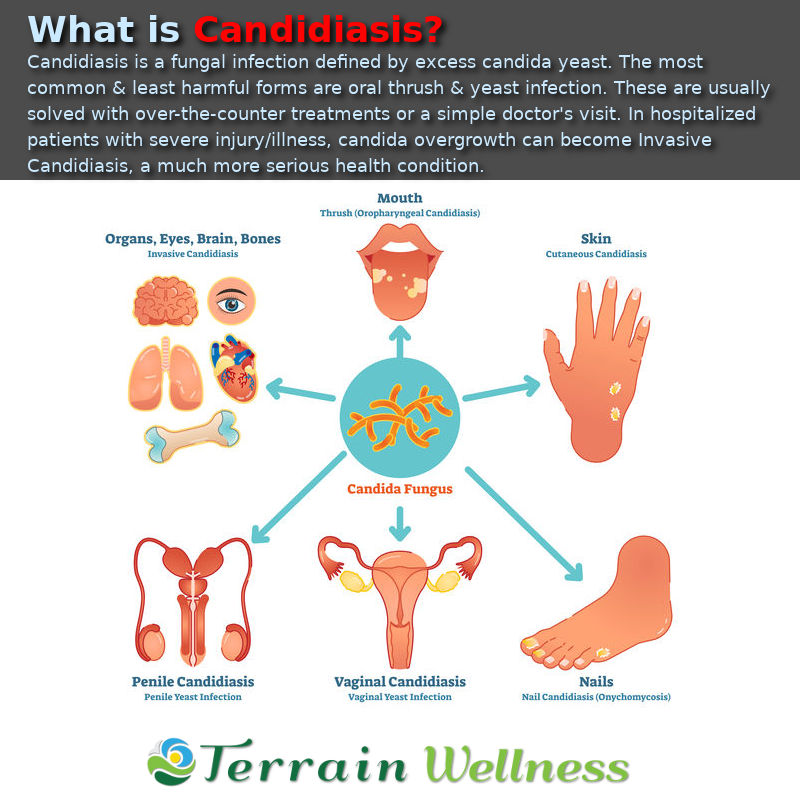
Candida Die Off Symptoms
-
Contents:
- Symptoms of Candida Die Off
- What is Candida?
- Candidiasis
- Invasive Candidiasis
- What Causes Candida Overgrowth?
- Toxins Released By Yeast Removal
- Treatment Options
- Conclusions
Candida die off symptoms include: weak/sore muscles, headache, digestive problems (gas, bloating, constipation or diarrhea), fatigue, fever, chills, rapid heartbeat, skin rashes/itching and a mild decrease in blood pressure. These symptoms arise when the Candida microorganisms living inside the body are rapidly destroyed, releasing waste and toxins that were once trapped inside these cells into the body all at once. These symptoms can arise from things like rapid changes in eating (candida diet), medications and the overgrowth hitting such a point that the offending fungus greatly outstrips its food supply. The process generally lasts about a week, be sure to report severe reactions or symptoms that last longer to your doctor.
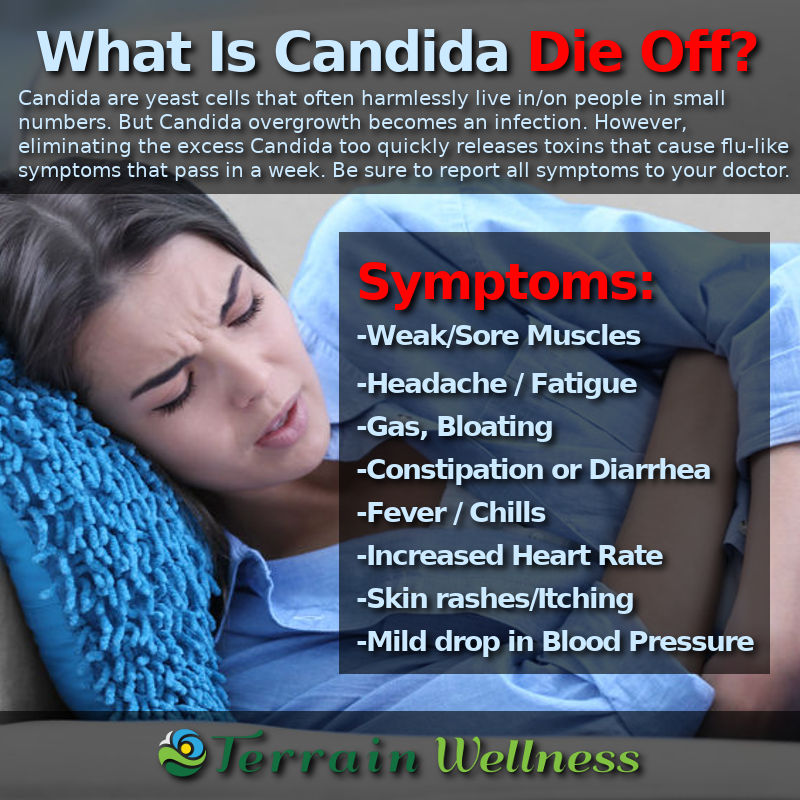
- weak/sore muscles
- headache
- digestive problems (gas, bloating, constipation or diarrhea)
- fatigue
- fever
- chills
- rapid heartbeat
- skin rashes/itching
- mild decrease in blood pressure
Symptoms of Candida Die-Off:
The usual response to Candida Die-Off Symptoms is to manage the reaction at home using Over-The-Counter medications or natural remedies. Although uncomfortable, these symptoms should pass in about a week or less. Nonetheless, be sure to tell your doctor because the symptoms you experience because they can sometimes be mitigated by reducing doses of medications. Very rarely, a person will have a serious allergic reaction to a medication, so severe symptoms should be reported to your healthcare team immediately. If you think you are having a medical emergency, call 911. That said, most cases are not serious and the symptoms may resolve on their own.
This cluster of symptoms was first observed when doctors began using antibiotics to treat disease and is known as the Jarisch-Herxheimer Reaction. Doctors noticed a strange phenomenon when treating sick patients with high doses of antibiotics: killing off the infection and curing the patient often produced strange flu-like symptoms. The most common reason cause of the Jarisch-Herxheimer Reaction are taking high doses of antifungals or antibiotics, but the condition can also occur when rapid changes of diet cause large-scale die-off of gut microflora overgrowth (also see: SIBO Diet).
What is Candida?
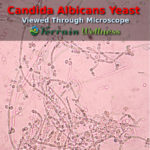
Candida is a type of yeast (a single-celled microorganism of the fungus family). Small numbers of this yeast are commonly found in human gut flora, in the mouth, on the skin and reproductive organs. Candida Albicans is the most prevalent variety, and is present within the GI tract of about half of healthy adults. The presence of candida on and within the human body is usually harmless, but it is still considered an “opportunistic pathogen” because an overgrowth results in an infection known as Candidiasis.
Candidiasis
Candidiasis is a fungal infection defined by an overgrowth of candida yeast. The most recognizable (and usually least harmful) forms being oral thrush or a yeast infection. In healthy people, these conditions are generally not serious and can usually be dealt with using over-the-counter treatments or a simple visit to the doctor.
Invasive Candidiasis
-
Risk Factors for Invasive Candidiasis
- Being an ICU Patient
- Multiple Surgeries
- Central Venous Catheters
- Pre-term babies
- Diabetics
- People being fed via IV
- Hospitalized patients receiving high doses of antibiotics
- Those with weakened immune systems: organ transplant, cancer, chemotherapy, HIV/AIDS
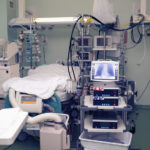
In those with compromised immune systems due to severe injury or illness, candida overgrowth can be more problematic. In hospital Intensive Care Units populated by medically fragile patients, the fungus can infect the bloodstream as well as organs like the liver, kidneys, heart and brain. This is a more serious medical condition known as invasive candidiasis. Invasive candidiasis can be hard to prevent in hospitals because these yeasts are normally present in/on our skin, mucous membranes and intestines. Making matters worse, medical researchers note that some strains of candida are evolving to become drug-resistant, making treating the condition more difficult (PubMed: Drug Resistance in Candida).
Most people do not need to be alarmed by the above statements because invasive candidiasis is a concern in the hospital environment and for at-risk patient groups, it is not a high concern for generally healthy people. But, be sure to speak with your doctor about your risk factors.
What Causes Candida Overgrowth?
- The Western/Standard-American Diet
- Antibiotics
- Hormone Drugs (Birth Control, Hormone Replacement)
- Slow Digestion
Contributing Factors for Candida Overgrowth

A discussion of candida die-off deserves some mention of what would cause an overgrowth. While there are a number of factors associated with fungal overgrowth in the body, the most common contributing factor is consuming too much sugar and refined carbohydrates. Other health conditions that make yeast overgrowth more likely include heavy antibiotic use, hormone medications (including birth control) and steroid medications. Medical research also shows a link between Candida overgrowth and chronic inflammation. Although Candida Albicans in the GI tract is generally considered benign, a growing body of evidence suggests that inflammatory lesions in the gut promote excess colonization of opportunistic pathogen yeasts. In turn, excessive yeast colonization of candida in the intestines leads to the release of of the pro-inflammatory cytokine IL-17 that leads to new lesions and even more yeast colonization.
…Candida colonization delays healing of inflammatory lesions and that inflammation promotes colonization. These effects may create a vicious cycle in which low-level inflammation promotes fungal colonization and fungal colonization promotes further inflammation. -PubMed, National Institute of Health
 Research is ongoing, but the evidence that links chronic inflammation to a host of health conditions and GI issues is becoming increasingly compelling as our understanding of gut microbiome continues to expand. The Western Diet (Standard American Diet) has long been associated with a host of preventable health conditions such as heart disease, diabetes and autoimmune conditions. With this new research into gut microflora, researchers are beginning to understand more about why & how the Standard American Diet is harmful.
Research is ongoing, but the evidence that links chronic inflammation to a host of health conditions and GI issues is becoming increasingly compelling as our understanding of gut microbiome continues to expand. The Western Diet (Standard American Diet) has long been associated with a host of preventable health conditions such as heart disease, diabetes and autoimmune conditions. With this new research into gut microflora, researchers are beginning to understand more about why & how the Standard American Diet is harmful.
The Western Diet that is high in refined carbs/sugar is the most common preventable risk factor among those with candida overgrowth. sweeteners like corn syrup and sugar alcohols like sorbitol that are found in many processed foods provide easy meals for yeast cultures that grow in the digestive tract. In fact, these simple carbohydrates are a perfect food-source for unhelpful
“Carbohydrates consumed in the diet are the primary and preferred nutrient sources for Candida albicans” -PubMed, National Institute of Health.
Anyone familiar with making bread or brewing beer will recall that these yeasts multiply quickly at warm temperatures when they have an ample food supply of simple carbohydrates. Bread yeasts are fed with carbohydrates in the form of flour or sugar, while yeast for alcohol is fed with carbohydrates like grains, sugar, fruit juice, honey, syrups/nectar etc. Given this, it makes sense that consuming large amounts of these types of foods would make one more likely to feed a candida overgrowth in the gut.
Hormone replacement drugs and hormone imbalance can also lead to increased instances of Candida overpopulation, particularly for cases of recurring female yeast infections. Hormonal changes create an environment wherein the balance between bacteria and fungus becomes imbalanced, leading to fungus (yeasts like candida) to take over. Interestingly, our food choices and gut health can have a notable influence on hormone imbalance (see: How to lose weight with Hashimoto’s). Poor gut health contributes to hormone imbalance, hormone imbalance encourages yeast overgrowth, yeast overgrowth promotes inflammation that taxes the immune system leading to even more fungal growth.
Another factor involved in properly balanced gut flora is GI motility. Overly slow digestion can encourage a number of unhealthy digestive issues including SIBO. It may be unpleasant, but when it takes too long to digest the food in our gut, that food can begin to rot inside us. This condition of food beginning to decompose inside of us can take the form of fungal proliferation.
- Candidalysin
-
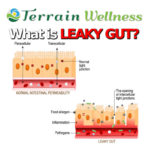
As the name implies, this peptide toxin is made by Candida yeast cells. Candidalysin damages human epithelial cells that make up the surface of our skin, blood vessels, organs and GI tract. Damaged epithelial cells in the GI tract may contribute to a health condition known as Leaky Gut, where food particles and contaminants begin leaking through the intestinal wall. - Acetaldehyde
-
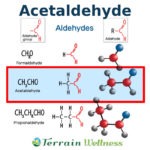
Acetaldehyde is a toxic liquid that is colorless, flammable and is noted to have a “suffocating” smell. It is also an intermediate chemical created as alcohol is metabolized in the body. Acute exposure to this substance causes irritation to skin, lungs and eyes. This substance is also believed to be a carcinogen. There are some some fruits, vegetables and fermented foods that contain some acetaldehyde, but those levels are generally considered safe. However, Candida overgrowth (and die-off) can produce harmful levels of acetaldehyde in the human body (see: PubMed Acetaldehyde & Candida). - Glycoconjugates
-
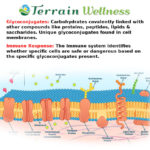 Glycoconjugates are carbohydrates that are chemically linked (covalent) with other compounds such as proteins and fats. These glycoconjugate compounds are found in cell membranes in living organisms and in the cell walls of yeasts like Candida Albicans. Each glycoconjugate has a unique chemical signature that living cells use to identify each other. When candida die-off occurs, yeast cell walls rupture and specific yeast glycoconjugates are released into the body in large quantities, triggering the body’s immune response when it recognizes a foreign invader. Because the body recognizes candida glycoconjugates as a foreign invader to be eliminated, there is medical research into developing glycoconjugate-based medications/vaccines to help the body recognize and fight off fungal infections (see: Fungal Glycans & Immune Recognition). .
Glycoconjugates are carbohydrates that are chemically linked (covalent) with other compounds such as proteins and fats. These glycoconjugate compounds are found in cell membranes in living organisms and in the cell walls of yeasts like Candida Albicans. Each glycoconjugate has a unique chemical signature that living cells use to identify each other. When candida die-off occurs, yeast cell walls rupture and specific yeast glycoconjugates are released into the body in large quantities, triggering the body’s immune response when it recognizes a foreign invader. Because the body recognizes candida glycoconjugates as a foreign invader to be eliminated, there is medical research into developing glycoconjugate-based medications/vaccines to help the body recognize and fight off fungal infections (see: Fungal Glycans & Immune Recognition). .
Toxins Released By Candida Die-Off:
- Reduce Medication Dosage
-

One of the most common causes of candida die-off symptoms is high doses of antifungal medications (antibiotics can also cause a Jarisch-Herxheimer Reaction). When yeasts are eliminated too quickly, the toxins held inside these microorganisms are released into the body. If you experience symptoms of a Jarisch-Herxheimer reaction, let your doctor know. Depending on your specific health conditions, your doctor may be able to lower your medication dosage so that the microbial die-off happens more slowly. By slowing down the process, your body may be better able to eliminate the toxins released by dying yeast cells.
- Activated Charcoal
-
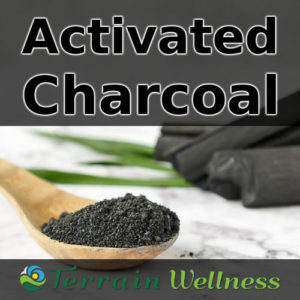
Activated Charcoal is used as a detoxifying agent in emergency medicine to treat overdoses and poisoning because of its unique ability to bind to toxins so they can be eliminated from the body. As with anything, there are pros and cons. If you decide to take activated charcoal, be aware that it can interfere with medications you may take and it can also deplete the body of vitamins and nutrients like magnesium. Lastly, be aware that activated charcoal can also cause constipation. Talk with your doctor to see if taking activated charcoal is right for you. - Bentonite Clay
-

Bentonite clay has been used internally and externally to treat a variety of conditions since ancient times. More than simply folklore, some of these uses may have merit to them. Medical research shows that bentonite is an effective detoxification agent for removing chemicals with a negative ionic charge from the body (PubMed Bentonite Clay). While bentonite clay is not known to deplete vitamins in the body, allow at least two hours of separation between taking bentonite and taking medications, supplements or vitamins. Be sure to ask your doctor if bentonite clay is safe for you. - Support The Liver & Kidneys
-
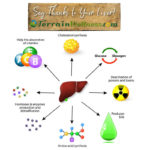
The toxins given off by microbes being eradicated within the body have to be processed and removed. Much of this detoxification occurs in the liver and kidneys. In Chinese Medicine, there are a number of herbs that are used to help support the liver and kidneys. Many of these herbs are used as seasonings or in food, so they’re generally considered safe. Even still, ask your doctor before trying them if you have any health condition related to the liver, kidneys or gallbladder. Herbs for Liver: Burdock Root, Dandelion Root, Turmeric, Licorice Root, Red Clover and Lemon Balm Flowering Herb. Kidney-supporting herbs may include: Dandelion Leaves, Marshmallow Root, Juniper, Nettles, Parsley, Red Clover and Ginger. In regard to kidney and liver support, it’s important to realize that these herbs are not intended to treat liver or kidney disease. Talk with your doctor to see if herbal supplements are right for you.
- Candida Diet

Those with Candida Overgrowth might experience a Jarisch-Herxheimer Reaction if they drastically change their diet too quickly. The overgrowth of yeast and bad gut bacteria in your GI tract will suddenly be cut off from their food supply, leading to a fast die-off. What does this mean to you? If you’ve eaten the Western Diet that is high in carbs and processed foods for a long time then you may not feel very good for a few days if you drastically change over to a healthier diet. That said, after a week or so, you’ll begin to feel much better without all the harmful gut bacteria and excess Candida. One solution may be to make these healthier changes incrementally, thereby slowing down the elimination of the yeast overgrowth. The Candida Diet is an elimination diet that seeks to lower candida concentrations in the body by restricting the yeast’s food supply. Carbohydrates, alcohol, processed foods, gluten, wheat, some dairy products, sugar and starches are avoided because these foods promote yeast growth. Lean Protein, non-starchy vegetables. In the candida diet, healthy fats, non-starchy vegetables and whole foods are eaten instead.- Stay Hydrated
-

It may seem overly simple, but the easy step of maintaining a healthy hydration level will help your body more easily process and eliminate the toxic byproducts left behind by yeasts that are being eliminated. The usual advice is about 8, 8 oz glasses of water per day, but your healthcare team will be able to advise you on what the proper amount is for your specific needs. In any case, proper hydration is key to eliminating the toxins that candida can leave behind.
Treatments for Candida Die-Off
Conclusions:
The unpleasant symptoms of Candida die off are the result of the Jarisch-Herxheimer Reaction where microbes in the body release toxic substances as they are destroyed. This process, while unpleasant, is not usually very harmful but be sure to communicate your symptoms with your doctor because you might need your medication to be adjusted depending on your health conditions. The symptoms shouldn’t last longer than a week, seek medical attention if you experience severe symptoms and communicate your symptoms with your doctor during the process. Stay hydrated and take some simple steps to help your body process and eliminate the toxins that candida can leave behind.
Yours in health,

About the author:
I am an Oregon licensed primary care physician as well as a licensed acupuncturist. While my status as a Doctor does give me full prescriptive rights, I prefer to use more gentle, natural techniques when possible. I attended USC School of Dentistry for my undergraduate degree and the National University of Natural Medicine for my doctorate. My status as both a physician and an acupuncturist trained in classical Chinese medicine gives me a unique perspective on healthcare.
Yours in health,
Dr. Danielle Lockwood & the Terrain Wellness Team.

